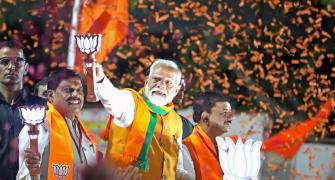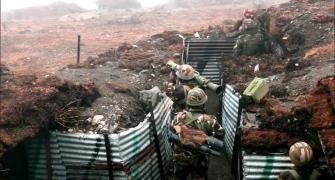When Mumbai-born architect Mukesh Mehta first waded into Dharavi a decade ago, he went in as - in his own words - a mercenary looking to make money. A lot of that stands to be made by developing the 144 hectares that Mumbai's famous slum is squatting over.
The ensuing years saw him become a missionary. "It has become a mission of my life to change Dharavi forever to make this city slum-free," says 57-year old Mehta, who would take home Rs 100 crore (Rs 1 billion) as fees for being the project management consultant to the Congress government in Maharashtra, which has drawn up a Rs 9,430 crore (Rs 94.3 billion) plan to redevelop Dharavi.
Dharavi's 600,000 residents, many of who are artisans (the area has a vibrant market in leather goods), will be rehabilitated and re-trained in higher paying craft, such as ceramics. Some 300 gems and jewellery export units are likely to be set up, each employing 250 workers. Schools are being set up and numerous jobs and business opportunities will created.
However, missionary zeal is not the only force driving the plan. Mehta has envisaged that 65 per cent of the freed land will be used to house the current residents. The rest will be given to real estate developers to set up commercial buildings and even a special economic zone, a business district that enjoys tax exemptions.
About 4,500 industrial units will be rehabilitated in the designated commercial area while the highly polluting leather industry and plastic recyclers will be moved to the city's outskirts. The going rates in the adjoining Bandra-Kurla Complex, which has quickly become a hotbed of financial services activity, are Rs 20,000-30,000 per square foot - higher than the rates in mega cities such as Singapore and Hong Kong.
Dharavi's redevelopment will make available 5 million square feet of new office and residential space in the near term and a humongous 40 million square feet over seven years.
Even if rates crash by half - an extreme situation - due to the increased supply, the redevelopment can still comfortably pay for all the rehabilitation and schools and spare enough cherries and cream for the developers.
Not surprisingly, the Slum Rehabilitation Authority of the Maharashtra government, which is overseeing the implementation of the project, has already sold as many as 50 documents, each of which costs Rs 100,000.
The buyers, according to industry sources, include Dubai-based realty majors Emaar Properties and Al Nakheel, and domestic biggies like Mukesh Ambani's Reliance Industries, Larsen & Toubro, DLF, Hiranandani Constructions, Mahindra Gesco, K Raheja Universal, HDIL, Kohinoor Realtors, Gamon Infrastructure and Kalpataru have snapped up the document. In addition, half a dozen companies from Israel, Hong Kong and Singapore have bought the documents, say sources.
Inevitably, with some people likely to make a lot of money, protests against the redevelopment have intensified. Last Monday, the entire Dharavi observed a bandh to protest against it. It does not help that India's financial capital, almost 60 per cent of whose 18 million people live in slums or on the street, has come out of the previous slum redevelopment plans with fingers charred. The developers made billions, but left the rehabilitated people sore with their low-quality dwellings.
In August 2001, a report by former municipal commissioner S S Tinaikar said the Shivsahi Punarvasan Prakalp, a company set up by the Shiv-Sena BJP, was designed just to enrich land developers. Tinaikar said several projects were simply abandoned by builders after taking advance from the government.
Building regulations were routinely violated. The track record of Slum Rehabilitation Authority, set up in 1995, is equally dismal. Stories abound of builders creating fake slum dwellers list to grab land.
Says 50-year-old Waljee Devjee Jetwa, a potter: "The government always makes empty promises. Give us the facilities and restore our livelihood."
Some are hurt because they were not taken into confidence. "The worst part is that they have not taken anybody's consent. Forcefully, they cannot take us even to Heaven," says Raju Korde, president of the Left Front-backed Dharavi Bachao Samiti. Mehta concedes that the consent of the slum dwellers has not been taken, but adds that the process of doing that would have taken five years.
However, the BJP-Shiv Sena combine, which started the slum redevelopment plan during its five-year rule in Maharashtra, is not opposing the plan.
Mehta attributes it to the absence of an alternative. Reprising the hackneyed comparison, he says: "If Mumbai wants to become Shanghai, they will have to support this project." One wonders how many of Dharavi's 600,000 residents, the most affected, would care.







